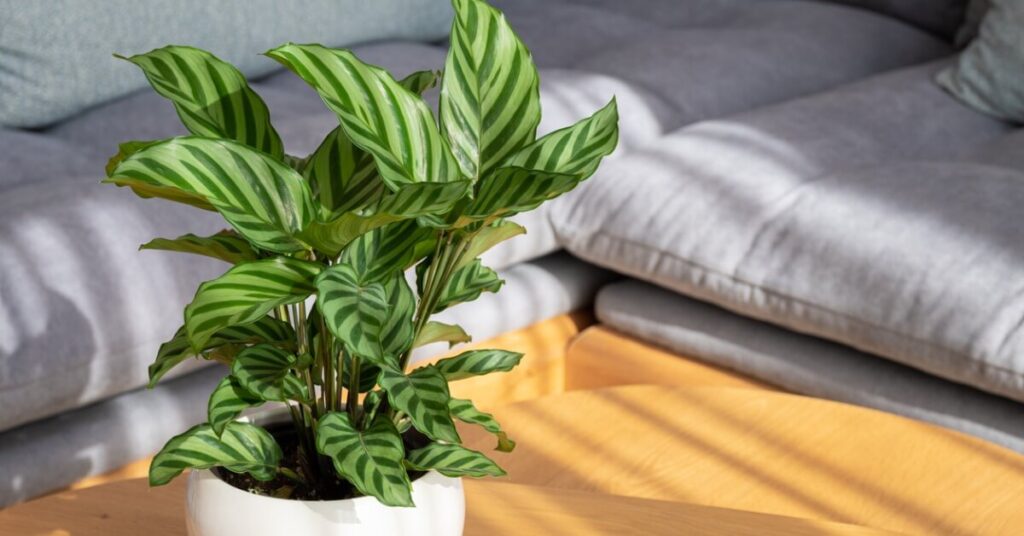Calathea Freddie (Goeppertia concinna) is an evergreen perennial favored for its lush, light green leaves, which are punctuated with beautiful dark green, symmetrical, and brushstroke patterns.
In their native homeland of Brazil and the tropical Americas, Calathea plants and leaves are used for handicrafts such as basket weavings and even as food wrappings.
Leaves can come in variegated forms featuring bright colors such as pink, orange, red, and white, with the occasional purple underside.
Other colloquial names include the peacock plant, cathedral window plant, zebra plant, rattlesnake plant, and (mistakenly) prayer plant.
Calathea Freddie Care
Calatheas are tough indoor tropical plants, able to survive many conditions, but are notorious for being a difficult and unforgiving plant.
Mistakes in caring for Calatheas often result in spotted or curling leaves. When healthy, Calathea leaves form a beautiful canopy over one another, and create a full, bushy plant that can grow up to 1 foot (30 cm) tall.
These plants are finicky, but the extra effort in care is worth the trouble as these plants are beautiful to have around, and can also shapeshift between day and night.
Soil
To prevent browning tips or curly edges, plant Calatheas in any moist, loamy, and water-retaining soil that is still able to drain well. Experts recommend neutral, slightly acidic (pH 6.5) garden soil (50% mix) high in organic matter such as orchid bark (20%), charcoal (20%), and perlite (10%).
Watering
Water when soil becomes dry 1 to 2 inches down, depending on pot size. Calatheas prefer distilled or filtered water, since tap water may turn their leaf edges brown or yellow.
Lighting
Growing on the jungle floors in the wild, Calatheas prefer shaded spots, away from bright windows and direct sun.
Humidity & Temperature
Calathea plants prefer high humidity above 50%. In their natural jungle floor habitats, humidities may reach 80-90%. Calatheas hate cold drafts or when temperatures drop below 55°F (13°C).
Fertilizing
In general, Calatheas do not require much fertilization except during active seasons (spring and summer), where a well-balanced houseplant fertilizer rich in nitrogen, phosphorus, and potassium should help their leaves stay healthy and full.
Common organic composts such as fish or seaweed emulsions, worm castings, tea leaves, etc. can be substituted for chemical fertilizers.
Propagation
Lacking nodes, Calatheas cannot be propagated from cuttings like other vine plants.
To propagate, gently unpot and cleave the plant in half along the natural root divisions before repotting in separate pots. Calatheas tend to clump together at the roots, but some gentle finger work should allow you to pull the plant apart at the roots without too much damage.
Propagate mature plants during the spring for best results, and water thoroughly the day before to reduce plant stress.
Diseases & Pests
Browning and yellowing on leaves may be signs of insect infestation. Check the undersides of leaves and the points where the stems meet the leaves for common invaders such as spider mites, mealybugs, fungus gnats, or tiny flies. Use houseplant insecticide or fungicide to kill invaders, or neem oil and warm, bleach-free dish soap for a more natural solution.
Common plant diseases on Calatheas include mold (look for black spots with yellow haloing), root rot, leaf-spot disease (look for reddish-brown spots on leaves), botrytis blight, powdery mildew (look for powdery white textures), etc.
Prune infected leaves, repot in new soil if necessary, and isolate infected plants in a warm, dry, and well-ventilated space. For leaf spots, use a copper fungicide.
Toxicity
Calatheas are non-toxic and non-poisonous to pets and people, but may cause stomach problems if over consumed.

